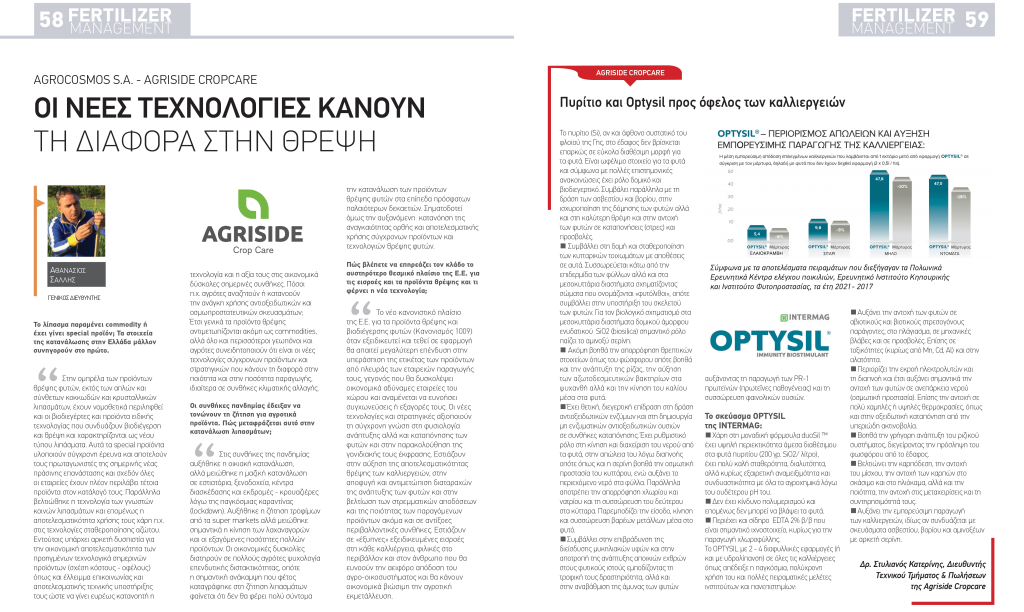Agriside CropCare published an advertisement in the printed magazine “Fertilizer management” of the company Agrenda for its well-known product, Optysil. Optysil is produced by the innovative company Intermag based in Poland and is one of the multinational companies represented by Agriside. At the same time, the general manager Sallis Athanasios answers some key questions and the technical and sales manager of Agriside, Dr. Stylianos Katerinis examines Silicon and the multiple benefits it offers to crops.
The article :
Does the fertilizer remain commodities or has it become a special product? Consumption data in Greece probably support the former.
In addition to simple and complex granular and crystalline fertilizers, bio-stimulants and special technology products that combine biostimulation and nutrition and are characterized as a new type of fertilizer have been legally included in the umbrella of plant nutrition products. These special products carry out modern research and are the protagonists of today’s new green revolution and almost all companies have now included such products in their list. At the same time, the technology of the known common fertilizers was improved and therefore their efficiency of use thanks to e.g. in nitrogen stabilization technologies. However, there is a lot of skepticism about the economic efficiency of today’s technologically advanced products (cost-benefit ratio) as well as a lack of communication and effective technical support to make their technology and value widely understood in today’s difficult economic conditions. How many e.g. Do farmers seek or understand the need to use antioxidants and osmoprotectants? So food products are generally still treated as commodities, but more and more agronomists and farmers are realizing that it is the new technologies of modern products and strategies that make the difference in quality and quantity of production, especially in conditions of climate change.
- Pandemic conditions have shown to stimulate demand for agricultural products. How does this translate into fertilizer consumption?
In the conditions of the pandemic, the domestic consumption increased, but the mass consumption in restaurants, hotels, entertainment centers and cruises – cruises decreased due to the global quarantine. The demand for food from the super markets increased but the movement of the vegetable markets and the exported quantities of many products decreased significantly. Economic hardships have left many farmers with a psychology of investment reluctance, so the significant recovery in fertilizer demand this year does not seem to bring plant nutrition to the levels of recent decades very soon. However, it signals the growing understanding of the need for proper and effective use of modern products and plant nutrition technologies.
- How do you see the strictest institutional framework of the EU affecting the industry? for inputs and food products and what does the new technology bring?
The new EU regulatory framework for plant nutrition and biostimulation products (Regulation 1009) when specialized and implemented will require greater investment in product label protection by their manufacturing companies, which will hamper financially weak companies in the area and is expected to favor mergers or acquisitions. their. New technologies and strategies utilize modern knowledge in the physiology of growth and stress of plants and in the monitoring of their gene expression. They focus on increasing crop nutrition efficiency, avoiding and treating plant growth disorders, and improving acreage yields and product quality even in adverse environmental conditions. They focus on “smart” specialized inputs in each crop, environmentally friendly and human-friendly that will favor the sustainable performance of the agro-ecosystem and will make agricultural exploitation economically viable.
Silicon and OPTYSIL for crops
Dr. Stylianos Katerinis, Technical & Sales Manager of Agriside Cropcare
Silicon (Si), although an abundant component of the Earth’s crust in the soil, is not sufficiently readily available to plants. It is a beneficial element for plants and according to many scientific announcements has a structural and biostimulatory role. It contributes in parallel with the action of calcium and boron, in the strengthening of the structure of the plants but also in the better nutrition and in the resistance of the plants to stresses and insults.
Contributes to the structure and stabilization of cell walls by depositing in them. It accumulates under the skin of the leaves but also in the intercellular spaces, forming bodies called “phytoliths”, so it contributes







